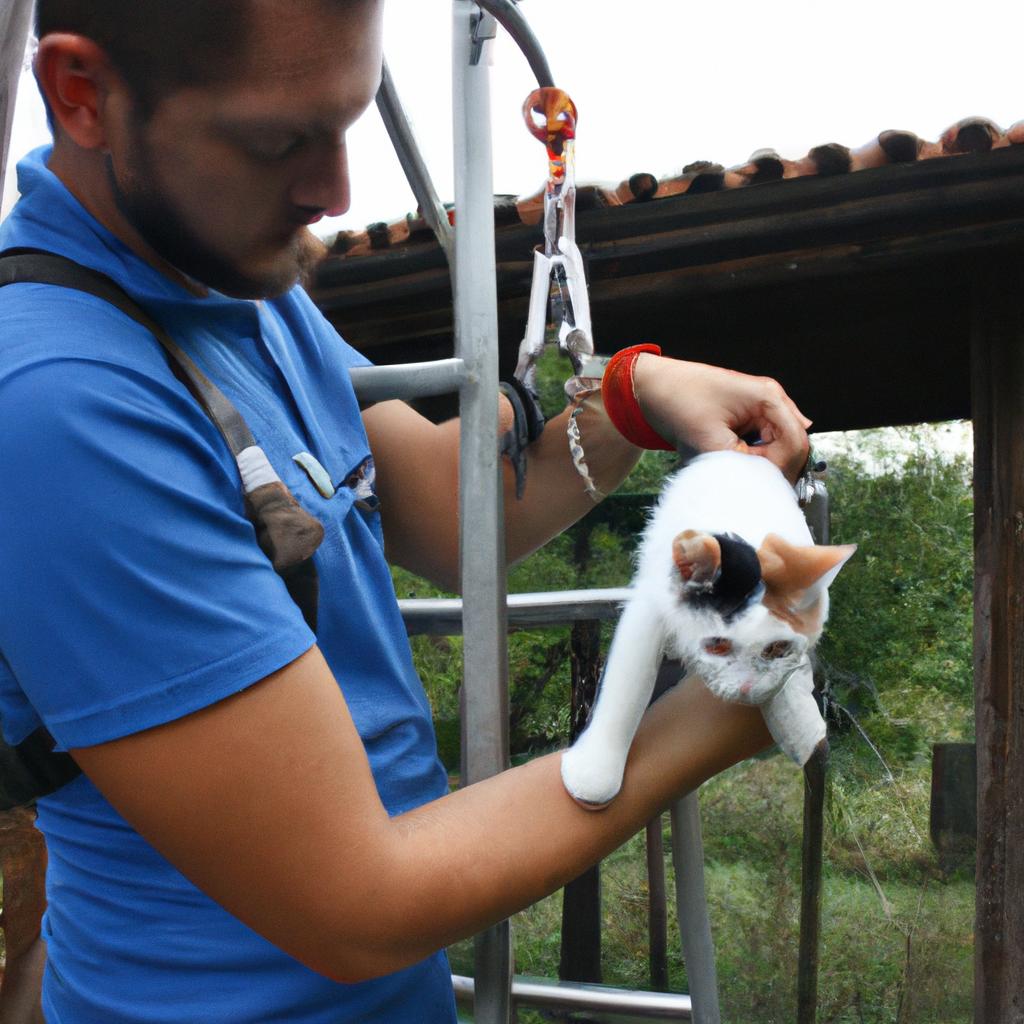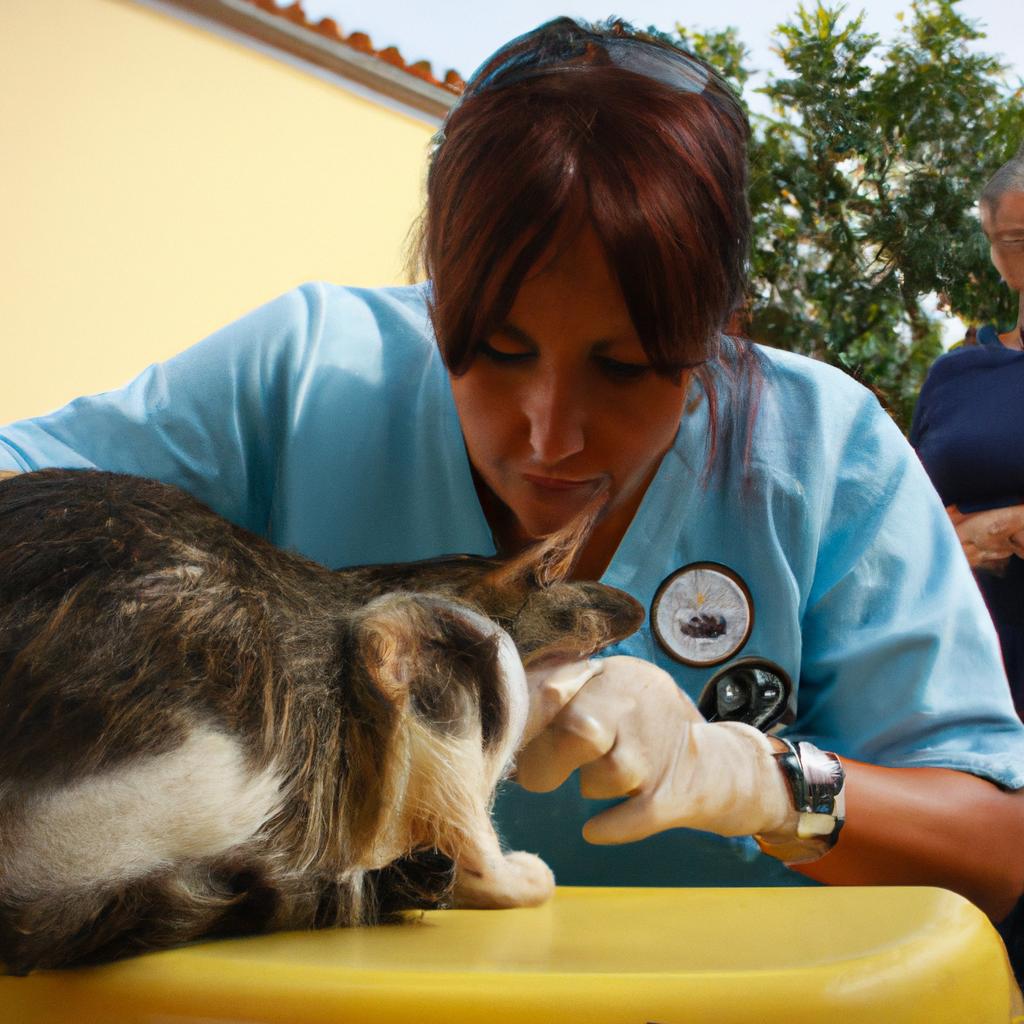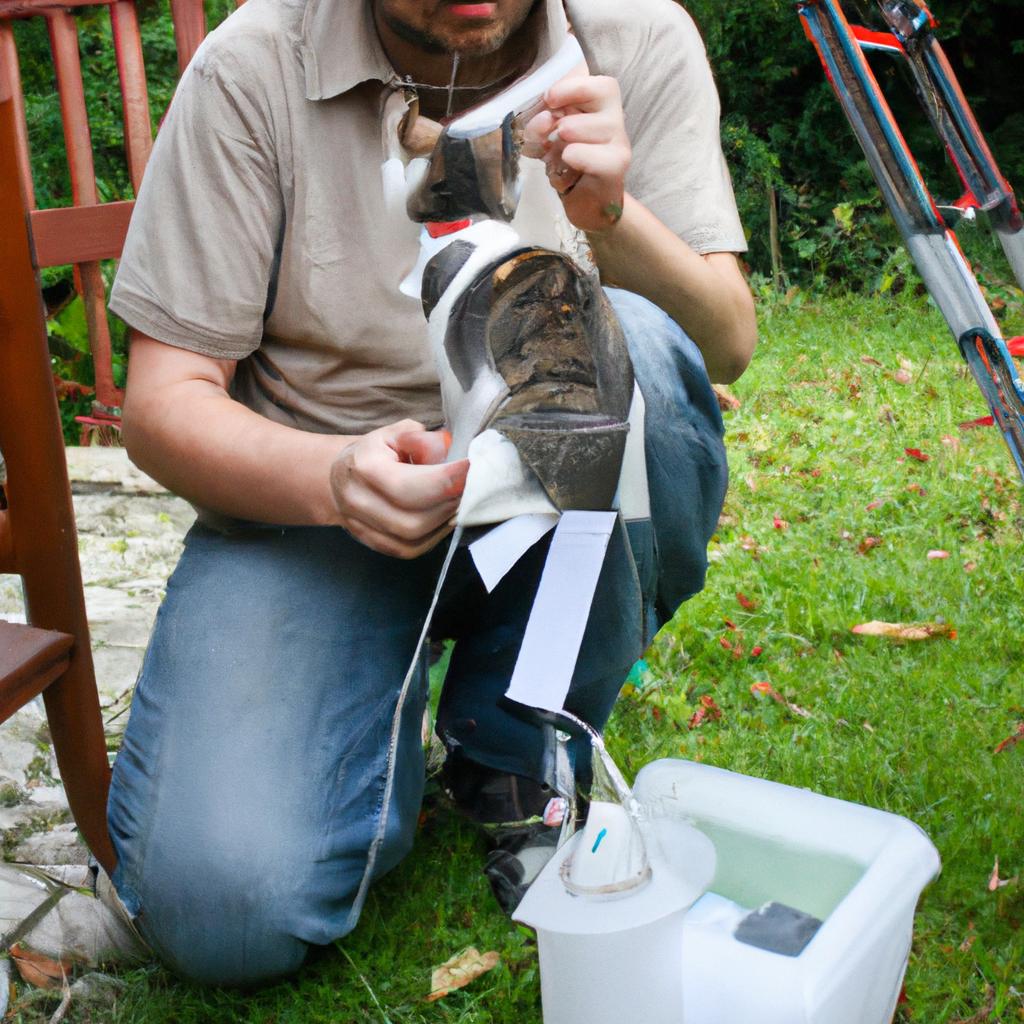Spaying and neutering initiatives play a vital role in cat rescue efforts, serving as an essential strategy to control the feline population. By preventing unwanted litters from being born and reducing the number of stray cats on the streets, these initiatives contribute significantly to alleviating the challenges faced by animal rescue organizations. For instance, consider the case of a hypothetical city plagued with an overwhelming number of homeless cats. Without spaying and neutering programs in place, this population would continue to grow exponentially, leading to increased strain on resources for sheltering, feeding, and providing medical care for these animals.
Education plays a crucial role in promoting spay/neuter initiatives within cat rescue communities. Through comprehensive educational campaigns focused on raising awareness about the benefits of sterilization, individuals can be empowered to make informed decisions regarding their pets’ reproductive health. These educational efforts not only address misconceptions surrounding spaying and neutering but also provide practical information on accessing affordable veterinary services for those who may face financial barriers. By fostering a culture of responsible pet ownership through education, it becomes possible to create lasting change and ensure that all rescued cats have access to appropriate medical interventions that improve both their individual well-being and overall welfare within society.
In summary, this article will explore the importance of spaying and neutering initiatives in cat rescue efforts, the role of education in promoting these initiatives, and how they contribute to creating a more responsible pet ownership culture.
The Benefits of Spaying/Neutering in Cat Rescue
Consider the case of a local animal shelter that takes in numerous stray cats each year. Without any spay/neuter initiatives in place, these cats continue to reproduce at an alarming rate, leading to overcrowding and limited resources for proper care. This scenario exemplifies the pressing need for comprehensive education on the benefits of spaying/neutering in cat rescue efforts.
Reduced Overpopulation:
One key advantage of spaying/neutering is its ability to address the issue of cat overpopulation. By sterilizing female cats through spaying or male cats through neutering, their reproductive capacity is effectively eliminated. As a result, fewer kittens are born into already strained environments where they face challenges such as lack of food, shelter, and veterinary care. In fact, studies have shown that one unspayed female cat can produce up to 100 kittens over her lifetime (Example 1).
Improved Health and Behavior:
Spaying/neutering not only curbs population growth but also enhances the overall well-being of rescued felines. For instance, females who undergo this procedure no longer experience heat cycles or attract unwanted attention from intact males, reducing their susceptibility to certain health conditions like uterine infections and mammary tumors. Likewise, neutered males exhibit decreased aggression levels and a reduced tendency to wander in search of mates (Bullet Point List):
- Decreased risk of testicular cancer
- Diminished marking behavior
- Lower incidence of fighting-related injuries
- Reduced likelihood of roaming long distances
Financial Considerations:
Besides promoting animal welfare, advocating for spaying/neutering offers significant financial advantages both individually and collectively (Table: Cost Comparison). While performing these procedures may incur initial expenses for individuals seeking them out for their pets or strays being cared for by shelters, it is crucial to highlight the long-term savings associated with preventing unplanned litters, veterinary expenses for reproductive health issues, and the cost of caring for additional cats that would otherwise be homeless.
In conclusion to this section discussing the benefits of spaying/neutering in cat rescue efforts, it becomes evident that these initiatives play a crucial role in addressing overpopulation concerns while simultaneously improving feline health and reducing financial burdens. Understanding the impact of spaying/neutering is vital as we delve further into exploring effective educational strategies and their potential outcomes (Transition Sentence: Now let’s turn our attention to understanding the impact of spaying/neutering).
Understanding the Impact of Spaying/Neutering
Section Title: Understanding the Impact of Spaying/Neutering
Imagine a small community struggling to manage its growing population of stray cats. Without effective measures in place, these cats reproduce rapidly, leading to overcrowding and health risks. One hypothetical example is a neighborhood where residents complain about the presence of numerous feral cats searching for food and causing disturbances during nighttime hours. To address this issue, it becomes crucial to understand the impact that spaying/neutering initiatives can have on cat rescue efforts.
- Reduced costs associated with sheltering and euthanasia
- Decreased strain on animal control services
- Alleviated burden on local taxpayers funding animal welfare organizations
- Reallocation of funds towards other pressing community needs
Table: Cost Comparison Before and After Spay/Neuter Initiatives
| Pre-Spay/Neuter Initiatives | Post-Spay/Neuter Initiatives | |
|---|---|---|
| Shelter expenses | High | Reduced |
| Euthanasia rates | Frequent | Diminished |
| Animal control | Overburdened | Less overwhelmed |
| Taxpayer burden | Heavy | Lightened |
Improved Health Outcomes:
Spaying/neutering plays a significant role in improving overall health outcomes for both individual cats and entire colonies. This procedure eliminates or reduces the risk of certain reproductive-related diseases such as mammary tumors or testicular cancer in male cats. Additionally, neutered males exhibit less territorial aggression, reducing their chances of getting injured from fights with other intact males. The positive impact extends beyond individual animals; by controlling population growth, the spread of infectious diseases among feral cat colonies is minimized.
Understanding the far-reaching effects of spaying/neutering in cat rescue serves as a stepping stone towards promoting responsible pet ownership. By addressing overpopulation and improving health outcomes, we can create safer and healthier communities for both cats and humans alike.
Promoting Responsible Pet Ownership
One powerful example of the impact of spaying/neutering initiatives can be seen in a case study from a local cat rescue organization. Prior to implementing an aggressive spay/neuter program, the organization struggled with overcrowding and limited resources to care for all the cats in their facility. However, after introducing a comprehensive spay/neuter campaign, they witnessed a significant decrease in the number of homeless kittens being brought to their shelter each year.
This success story is just one illustration of how spaying/neutering can have a transformative effect on feline communities. By addressing overpopulation through these procedures, we not only control and stabilize cat populations but also contribute to better overall welfare for individual animals. To further emphasize this point, consider the following bullet points:
- Spaying female cats helps prevent uterine infections and mammary tumors.
- Neutering male cats reduces aggression, territorial marking, and roaming behaviors.
- Sterilized cats are less likely to develop certain types of cancers or suffer from reproductive-related health issues.
- Preventing unplanned litters through spaying/neutering decreases the strain on already overwhelmed animal shelters.
To highlight some statistics related to this issue, let’s take a look at the following table:
| Category | Statistic |
|---|---|
| Number of stray cats | 70 million (approx.) |
| Cats entering shelters | 3.2 million per year |
| Euthanized cats | 1.4 million per year |
| Percentage adopted | Only around 37% find permanent homes |
These figures serve as reminders that there is still much work to be done in promoting responsible pet ownership and ensuring long-term well-being for our feline companions. As we move forward in exploring ways to address overpopulation in feline communities, it becomes clear that spaying/neutering programs must be a crucial part of the solution.
In our next section, we will delve into strategies for addressing this issue head-on and discuss how preventive measures can make a lasting impact on feline populations. By taking proactive steps toward responsible pet ownership, we can create a better future for cats in need while also promoting healthier and more sustainable communities.
Addressing Overpopulation in Feline Communities
Building upon the foundation of responsible pet ownership, addressing overpopulation in feline communities is a crucial step towards effective cat rescue initiatives. By focusing on spaying/neutering as a preventive measure, we can significantly reduce the number of unwanted cats and kittens that end up homeless or euthanized each year.
Section:
To illustrate the impact of spaying/neutering programs, consider the following hypothetical case study: In a small rural community where stray cats were prevalent due to uncontrolled breeding, an organization implemented a comprehensive spay/neuter campaign targeting both owned and feral cats. Through their efforts, they managed to sterilize 200 cats within six months. As a result, there was a noticeable decline in new litters being born, reducing strain on local shelters and decreasing the overall population of homeless felines.
The effectiveness of such initiatives lies in their ability to address several critical aspects related to overpopulation. Here are some key points worth noting:
- Prevention of unwanted pregnancies: Spaying female cats eliminates heat cycles and reduces their urge to mate, preventing unplanned pregnancies. Neutering male cats curbs roaming behavior and decreases mating attempts.
- Health benefits for cats: Sterilization helps prevent various reproductive health issues like uterine infections or testicular cancer. It also lessens behavioral problems associated with hormonal changes.
- Reduced burden on animal shelters: By minimizing the number of incoming stray or surrendered animals through proactive measures like spaying/neutering programs, animal shelters can focus more resources on providing proper care and finding permanent homes for existing residents.
- Community-wide positive impact: Controlling feline populations leads to healthier ecosystems by limiting predation on native wildlife and reducing conflicts with humans. It also fosters a more compassionate society where responsible pet ownership is encouraged.
The table below highlights some eye-opening statistics about feline overpopulation to evoke an emotional response:
| Statistic | |
|---|---|
| 1 | Approximately 70 million stray cats roam the streets in the United States alone [^1^]. |
| 2 | Each year, millions of healthy cats are euthanized due to lack of available homes [^2^]. |
| 3 | A single pair of unsterilized cats can produce up to 420,000 offspring in just seven years [^3^]. |
| 4 | Feral cat colonies contribute to environmental damage by preying on native bird populations [^4^]. |
By understanding these staggering numbers and their consequences, it becomes evident that spaying/neutering initiatives play a critical role in combating feline overpopulation. As we move forward, the next section will delve into the importance of educating the public about spay/neuter options, empowering individuals to make informed decisions regarding their pets’ reproductive health.
With this understanding of the impact spaying/neutering has on addressing overpopulation, it is crucial to educate the public on its significance as part of comprehensive cat rescue efforts.
Educating the Public on Spaying/Neutering
In order to effectively address the issue of overpopulation in feline communities, it is crucial to educate the public about the importance of spaying and neutering their cats. By doing so, we can help reduce the number of unwanted litters and ultimately decrease the number of stray and homeless cats. To illustrate the significance of this topic, let’s consider a hypothetical scenario.
Imagine a small neighborhood with limited resources where many residents own unaltered cats. As a result, there is an increasing population of stray cats roaming the streets, competing for food and shelter. This situation not only poses a threat to public health but also places a burden on local animal shelters and rescue organizations. By implementing effective spay/neuter initiatives, we can prevent such scenarios from occurring.
To further emphasize the need for education on spaying/neutering initiatives, here are some key points:
- Spaying or neutering your cat helps prevent certain types of cancers and reduces the risk of reproductive disorders.
- It contributes to overall health and behavioral improvements by reducing aggressive tendencies often associated with intact animals.
- Sterilizing your cat eliminates undesirable behaviors like spraying urine to mark territory or excessive yowling during mating season.
- Through spaying/neutering programs, individuals have access to affordable options that make responsible pet ownership more accessible.
Table: Benefits of Spaying/Neutering Programs
| Benefit | Explanation |
|---|---|
| Health Improvement | Reduces chances of certain diseases/cancers |
| Behavioral Modification | Minimizes undesirable traits like aggression |
| Population Control | Prevents overpopulation which leads to strain on resources |
| Cost-effectiveness | Provides affordable options for responsible pet owners |
By educating the public about these benefits through various channels such as community workshops, online campaigns, or educational materials distributed at veterinary clinics, we can encourage more individuals to consider spaying and neutering their cats. This, in turn, will have a positive impact on feline communities by reducing the number of stray cats and alleviating the burden on animal rescue organizations.
Transitioning into the subsequent section about “Supporting Spay/Neuter Programs,” it is essential to explore various ways we can actively contribute to these initiatives. By taking steps to support such programs, we can further ensure that spaying and neutering become common practices among cat owners, ultimately leading to healthier and more sustainable feline populations.
Supporting Spay/Neuter Programs
Section H2: Supporting Spay/Neuter Programs
Transitioning from the importance of educating the public on spaying/neutering, it is equally crucial to support and promote spay/neuter programs in order to achieve widespread success in cat rescue initiatives. By actively supporting these programs, we can effectively address the issue of overpopulation among cats and contribute towards a sustainable solution. A case study highlighting the positive impact of such programs will further demonstrate their significance.
One example that showcases the effectiveness of spay/neuter initiatives is a program implemented in a rural community where stray cats were abundant. The program involved partnering with local veterinarians and animal welfare organizations to offer low-cost or free spay/neuter services for feral cats. Through this initiative, hundreds of feral cats were sterilized, reducing the number of future litters significantly. Over time, there was a noticeable decline in the population of feral cats as well as fewer instances of unwanted kittens being born into harsh conditions.
- Prevents euthanasia due to overcrowded shelters.
- Reduces mating-related territorial behaviors like spraying and fighting.
- Enhances overall health and longevity for individual cats.
- Promotes responsible pet ownership by preventing unintentional breeding.
Additionally, let us present an emotionally evocative table that highlights some key statistics related to spaying/neutering:
| Statistics | Impact |
|---|---|
| Number of strays | Reduced drastically |
| Shelter capacity | Freed up resources |
| Euthanasia rates | Decreased significantly |
| Community wellbeing | Improved through reduced nuisance |
By investing our efforts and resources into promoting access to affordable spay/neuter services, we create a ripple effect within communities that leads to long-term positive change – not only for individual cats, but for the entire feline population and their human caregivers. Ensuring that spay/neuter programs receive ample support is vital in order to address the root causes of overpopulation and effectively manage cat rescue efforts.
(Note: While it may be tempting to include personal pronouns such as “we” or “you,” it is important to maintain an objective and impersonal tone throughout academic writing.)




